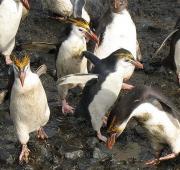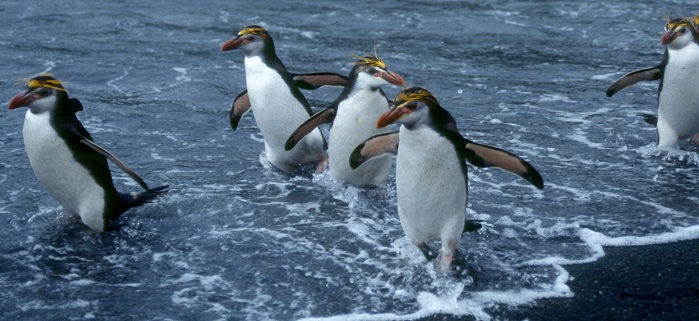Reproduction
The Eudyptes schlegeli, or Royal
Penguins, are found
usually in subantarctic climates and islands. The Royal Penguins
are aquatic and flightless birds that reproduce sexually and lay
eggs. The common time period for the Eudyptes schlegeli to lays
its eggs are in the month of October, generally around the 20-23
day of the month (Hindell et al. 2012.) The date that the penguins choose to lay their eggs is affected by the climate,
warmer weather usually brings about an earlier time to lay their
eggs (Hindell et al. 2012.) Eudyptes schlegeli are colonial
breeders (Holmes. 2007.) which means that they tend to breed in
large groups of birds for protection from predators as well as
warmth and blocking of the strong winds of their habitats. The
favorite place for a Royal Penguin to lay its eggs are in very
open and easily accessible nest sites such as smooth beaches or
plains (Holmes. 2007.) When the Royal Penguin lays its eggs it
usually lays two eggs (Hindell et al. 2012.) This is because
when it lays both of its eggs it tends to only have the second
egg survive and hatch. The first egg is usually smaller and has
a less chance of survival than the second egg does (St Clair.
1995.) In many instances the Eudyptes schlegeli have even
ejected their own first egg from the nest due to lack of size
and predicted survival of their young (St Clair. 1995.) An
observing scientist recorded that out of one hundred and thirty
seven first eggs, only one actually survived until it was able
to hatch. While the egg is incubating, unlike many other species
of penguins, the Royal Penguins are watched over by their mothers
and not their fathers (St Clair. 1995.) The eggs of the Royal
Penguins are usually incubated for around 30 days after being
laid until they hatch.
penguins choose to lay their eggs is affected by the climate,
warmer weather usually brings about an earlier time to lay their
eggs (Hindell et al. 2012.) Eudyptes schlegeli are colonial
breeders (Holmes. 2007.) which means that they tend to breed in
large groups of birds for protection from predators as well as
warmth and blocking of the strong winds of their habitats. The
favorite place for a Royal Penguin to lay its eggs are in very
open and easily accessible nest sites such as smooth beaches or
plains (Holmes. 2007.) When the Royal Penguin lays its eggs it
usually lays two eggs (Hindell et al. 2012.) This is because
when it lays both of its eggs it tends to only have the second
egg survive and hatch. The first egg is usually smaller and has
a less chance of survival than the second egg does (St Clair.
1995.) In many instances the Eudyptes schlegeli have even
ejected their own first egg from the nest due to lack of size
and predicted survival of their young (St Clair. 1995.) An
observing scientist recorded that out of one hundred and thirty
seven first eggs, only one actually survived until it was able
to hatch. While the egg is incubating, unlike many other species
of penguins, the Royal Penguins are watched over by their mothers
and not their fathers (St Clair. 1995.) The eggs of the Royal
Penguins are usually incubated for around 30 days after being
laid until they hatch.
Once the chick is born it is guarded and
raised by the father for about three to four weeks before the
chick is ready to join the main group of penguins. The young
Royal Penguins are still fed by their parents until late in
January when the whole group of Eudyptes schlegeli return to
live in the sea until the following breeding season. This can be
shown by the new chicks beginning to molt at the age of about
sixty days which shows that they are ready to start hunting for
themselves (see adaptation page). After that, the young Royal
Penguin spends the next
five to six years maturing and hunting in the ocean before it is
ready to start laying its own eggs. During the first few years that the
Eudyptes schlegeli attempt to lay eggs, the young
parents are usually
unsuccessful. Reproductive attempts can begin at the age of about five to six
years old, but they do not raise strong, healthy offspring
generally until the age of about
ten years.
In its life the Eudyptes schlegeli live to be around fifteen to
 twenty years
old (A-Z Animals. 2013.) They also grow to an average
weight of six and a half to thirteen pounds and have an average
height of twenty four to twenty seven inches (A-Z Animals. 2013.)
Throughout its life, the Royal Penguins tend
to stay in the Antarctic waters and the rocky islands that
surround them; they are not migratory birds so movements of
large distances are not common. The Royal Penguins simply stay
where they are, swim around in the ocean to hunt, and return to
Macquarie Island to mate and lay their eggs as well as raise
their young for the first few months. Ultimately, the Eudyptes
schlegeli live a simple life of swimming in the ocean for food
and then returning to islands for mating season.
twenty years
old (A-Z Animals. 2013.) They also grow to an average
weight of six and a half to thirteen pounds and have an average
height of twenty four to twenty seven inches (A-Z Animals. 2013.)
Throughout its life, the Royal Penguins tend
to stay in the Antarctic waters and the rocky islands that
surround them; they are not migratory birds so movements of
large distances are not common. The Royal Penguins simply stay
where they are, swim around in the ocean to hunt, and return to
Macquarie Island to mate and lay their eggs as well as raise
their young for the first few months. Ultimately, the Eudyptes
schlegeli live a simple life of swimming in the ocean for food
and then returning to islands for mating season.
